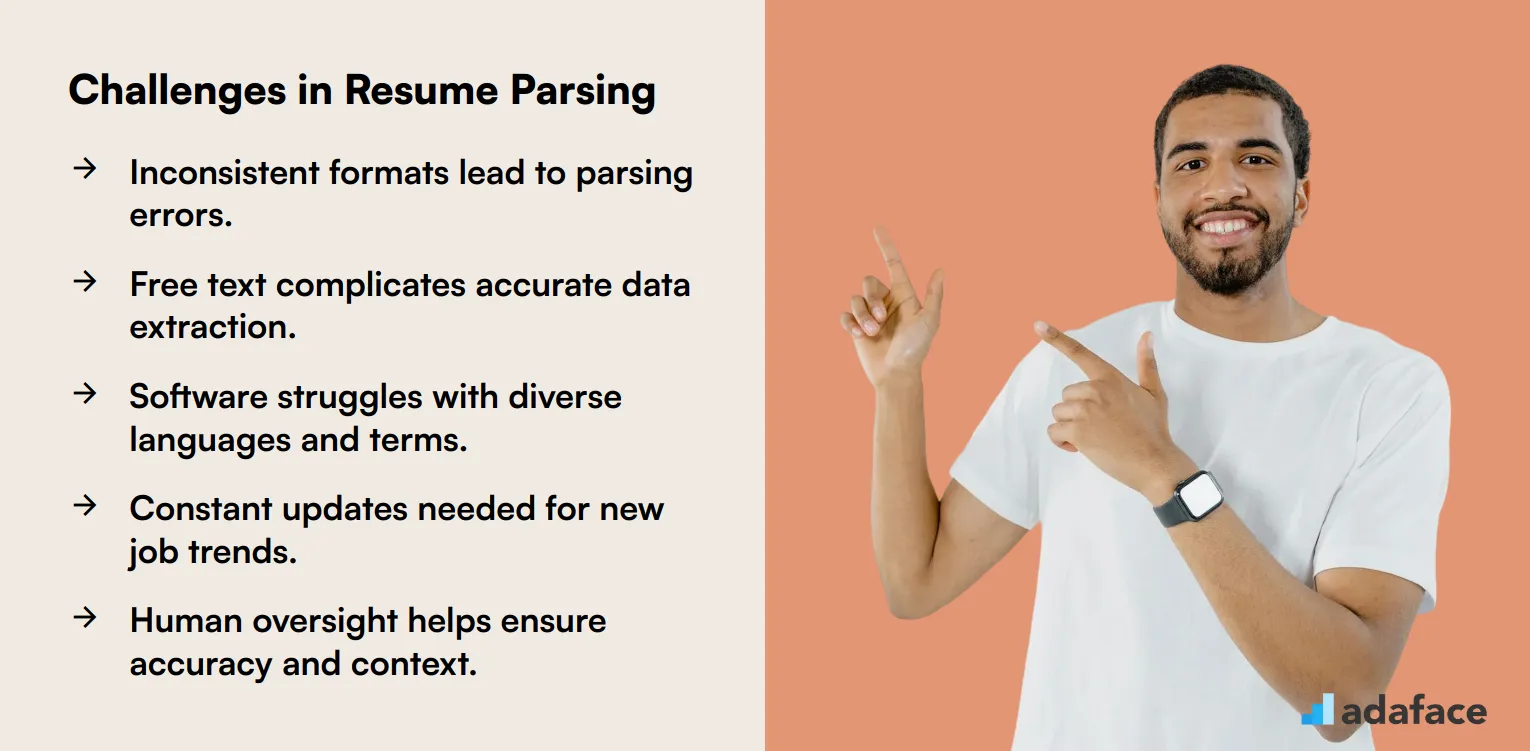Resume parsing is like having a super-smart robot sift through piles of resumes for you. It extracts key information from resumes, like skills and experience, and puts it into a structured format.
This technology helps recruiters quickly identify qualified candidates and streamline the hiring process. Think of it as the first step to better screening candidates.
Table of contents
Resume Parsing
Resume parsing is the process of extracting relevant information from resumes and converting it into structured data. This technology helps recruiters and HR professionals quickly analyze large volumes of resumes, saving time and improving the efficiency of the hiring process.
Imagine receiving hundreds of applications for a single job opening and having to manually review each resume. With resume parsing, you can automatically extract key details like contact information, work experience, and skills, allowing you to focus on evaluating candidates rather than data entry.
What is Resume Parsing?
Resume parsing is the process of extracting relevant information from resumes and converting it into a structured format. This technology allows recruiters and hiring managers to quickly analyze large volumes of resumes, saving time and improving efficiency in the recruitment process.
The parsing software scans resumes for key details such as contact information, work experience, education, and skills. It then organizes this data into a standardized format that can be easily searched, sorted, and compared across multiple candidates.
Modern resume parsers use advanced techniques like natural language processing and machine learning to improve accuracy. These technologies help the parser understand context and identify important information even when resumes have varying formats or unconventional layouts.
Parsed resume data can be directly imported into applicant tracking systems (ATS) or other recruitment software. This integration streamlines the hiring workflow and allows for more effective candidate management and evaluation.
While resume parsing greatly enhances recruitment efficiency, it's important to note that human oversight is still crucial. Recruiters should review parsed data for accuracy and consider the overall context of a candidate's experience beyond just the extracted information.
How Does Resume Parsing Work?
Resume parsing is a technology-driven process that extracts relevant information from resumes to streamline recruitment. It works by scanning resumes and converting unstructured data into a structured format for easy analysis.
The process begins with the extraction of key details such as contact information, skills, education, and work experience. This data is then organized into a predefined format, making it easier for recruiters to review and compare candidates.
Advanced resume parsing tools utilize natural language processing (NLP) to understand context and nuances in resumes. This allows for more accurate extraction of information, even from complex or creatively formatted documents.
Once the data is structured, it can be integrated into applicant tracking systems (ATS) for further processing. This integration helps in building a candidate funnel and enhances the efficiency of the recruitment process.
By automating the initial screening of resumes, parsing tools save time and reduce the potential for human error. This allows recruiters to focus on more strategic tasks, such as candidate nurturing and engagement.
Benefits of Using Resume Parsing in Recruitment
Benefits of Using Resume Parsing in Recruitment
Resume parsing is like having a super-powered assistant that helps you sort through a mountain of resumes. It extracts information from resumes and structures it in a way that makes it easy for recruiters and hiring managers to find the best candidates.
One of the biggest advantages is the time it saves; imagine not having to manually read every single resume. This allows recruiters to focus on more strategic tasks like candidate nurturing and building relationships.
Resume parsing also helps improve the accuracy of your data. By automating data entry, you reduce the risk of human error, ensuring that your candidate database is clean and reliable. This structured data then enables better reporting and analysis of your recruitment efforts.
Another key benefit is enhanced candidate experience. With faster resume screening, you can respond to applicants more quickly, creating a positive impression of your company and improving your employer branding.
Common Challenges in Resume Parsing
Resume parsing is a powerful tool in recruitment, but it comes with its own set of challenges. Understanding these challenges can help recruiters and hiring managers make better use of this technology in their hiring process.
One common challenge is the inconsistency in resume formats. Candidates use various templates and styles, which can lead to parsing errors and misinterpretation of data.
Another issue is the handling of unstructured data. Resumes often contain information in free text, making it difficult for parsing software to accurately extract relevant details.
Parsing accuracy can also be affected by the software's ability to recognize and interpret different languages and terminologies. This can lead to incomplete or incorrect candidate profiles.
Lastly, there's the challenge of keeping up with the ever-evolving job market and resume trends. As new skills and roles emerge, parsing tools need constant updates to remain effective.
Addressing these challenges requires a combination of advanced technology and human oversight to ensure that the best candidates are identified and shortlisted.

How to Choose the Right Resume Parsing Tool
Choosing the right resume parsing tool can significantly enhance your recruitment process. It's important to consider factors like accuracy, ease of integration, and scalability to ensure it meets your organization's needs.
Start by evaluating the tool's compatibility with your existing systems. This includes checking if it integrates smoothly with your applicant tracking system and other HR software.
Next, assess the tool's ability to accurately extract and interpret data from various resume formats. A tool with robust data extraction capabilities will help you avoid missing out on potential candidates due to format issues.
Consider the tool's scalability to ensure it can handle your recruitment volume, especially during peak hiring periods. This ensures that the tool remains effective as your organization grows or experiences a hiring surge.
Finally, look for a tool with a user-friendly interface that allows your team to quickly learn and use it without extensive training. This will help in reducing the learning curve and improving overall efficiency in the recruitment process.
Future Trends in Resume Parsing Technology
Resume parsing technology is evolving, and future trends are set to reshape the recruitment landscape. One major trend is the integration of artificial intelligence to enhance parsing accuracy and efficiency. AI can analyze resumes with greater precision, reducing human error and bias. This shift aligns with the growing emphasis on inclusive hiring, ensuring diverse candidate pools are fairly assessed.
Another emerging trend is the use of natural language processing (NLP) to interpret resumes. NLP allows systems to understand context and nuances in language, improving the parsing of complex resumes. This technology can identify skills and experiences that might be overlooked by traditional methods. It also facilitates better matching of candidates to job requirements.
Cloud-based resume parsing solutions are gaining traction, offering scalability and flexibility. These solutions enable recruiters to access and manage resumes from anywhere, streamlining the recruitment process. Additionally, cloud technology supports collaboration among hiring teams, enhancing decision-making and candidate selection.
Data-driven insights are becoming integral to resume parsing technology, providing recruiters with valuable analytics. These insights help in understanding candidate trends and improving recruitment strategies. By leveraging data, companies can make informed decisions, optimizing their hiring processes. This approach aligns with the broader trend of talent analytics in HR.
Finally, the integration of resume parsing with applicant tracking systems (ATS) is set to become more seamless. This integration ensures that candidate information flows smoothly through the recruitment funnel. It enhances the overall candidate experience, making the application process more efficient and user-friendly.
Conclusion
Resume parsing is a super helpful tool for recruiters, like a smart assistant that helps you sort through lots of resumes quickly. By understanding the basics and how to pick the right tool, you can make your hiring process way smoother and find the best people for your team.
Keep an eye on how resume parsing is changing, as new tech like AI keeps making it even better. As Adaface continues to innovate, we're here to help you stay ahead and make hiring easier and more effective.
Resume Parsing FAQs
Most resume parsing tools can handle common file formats like PDF, DOC, DOCX, TXT, and sometimes even image-based resumes using OCR (Optical Character Recognition) technology.
Accuracy varies depending on the tool and the resume's formatting. However, good resume parsers can achieve high accuracy rates, often above 90%, especially with well-formatted resumes.
Yes, by standardizing data extraction, resume parsing can help ensure compliance with regulations like GDPR. It also helps anonymize data for blind hiring initiatives.
Look for features like accurate data extraction, support for multiple file formats, integration with your ATS, customization options, and data security measures.
Resume parsing saves time by automating the data entry process. It reduces the manual effort of reviewing each resume individually and entering the information into your system.
Yes, resume parsing can be used across various roles and industries. Its ability to extract relevant information makes it a versatile tool for any organization dealing with a high volume of applications.

40 min skill tests.
No trick questions.
Accurate shortlisting.
We make it easy for you to find the best candidates in your pipeline with a 40 min skills test.
Try for freeRelated terms



